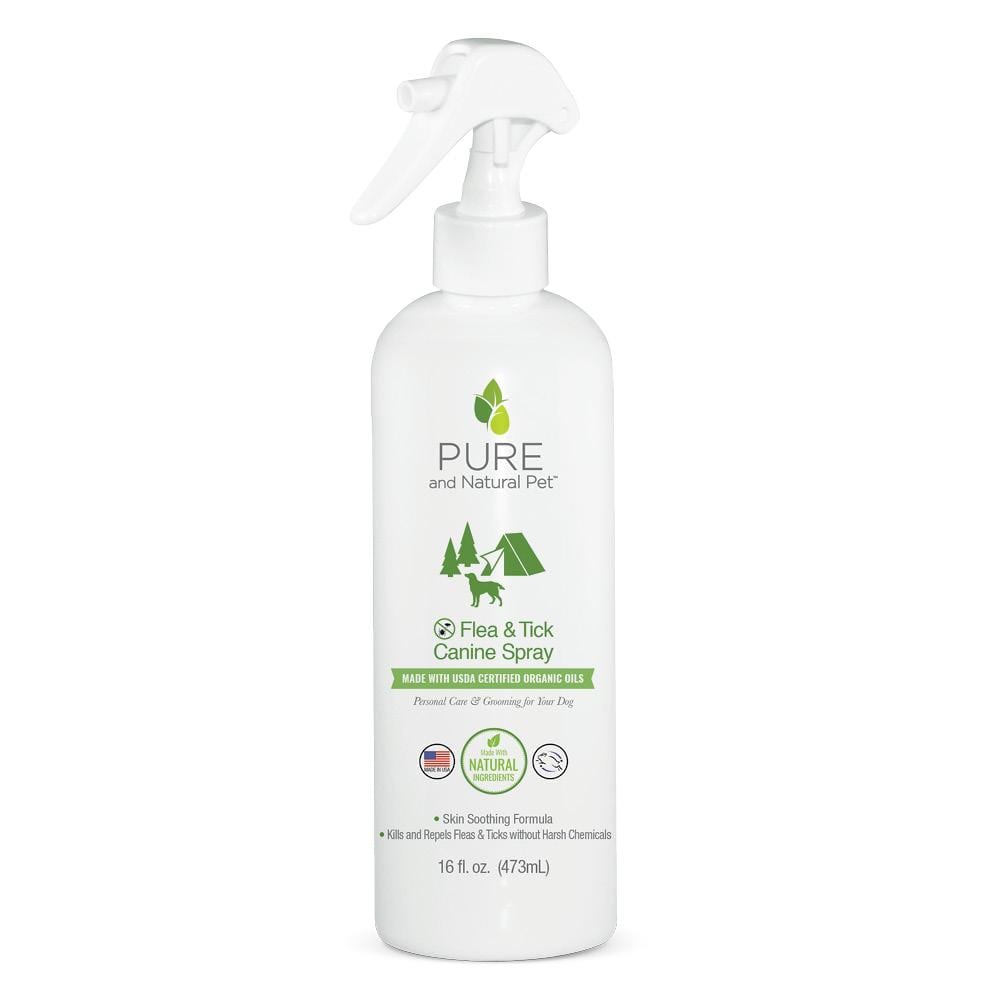The weather is getting warmer and slowly but surely, your vet will most likely start bringing up flea and tick prevention with you at your next visit or, directly to your inbox. Like everyone, we also do not want our pets or homes exposed to fleas or ticks but we also have to be mindful of the serious risks that come alongside most conventional forms of prevention.
The worst part is, these toxic treatments do not guarantee 100% protection so even after your dog gets their medicated treatments, they can still get fleas and ticks, all while possibly having severe adverse reactions to the medications.
Call us crazy but, we would like to avoid this scenario… naturally, in a way that does not harm your pet, yourself, or your home environment.
Risks of Chemical Flea & Tick Treatments-
First…why naturally? What’s wrong with the usual flea and tick preventatives/treatments that my family vet recommends?
For starters, topical flea and tick medications are classified as “pesticides” and are regulated by the Environmental Protection Agency (EPA). Oral flea and tick medications are considered “drugs” and are regulated by the Food and Drug Administration (FDA).
You may think it is no big deal to feed your pet these preventatives but we must remember that these are neurotoxins designed to kill insects. The product labels indicate that they are considered harmful to humans. Do we really want to apply or administer such products to our pets? Even worse, these products can persist in their system for weeks to months.
Both spot-on topicals and oral medications have significant adverse effects associated with them, such as-
- Skin irritations
- Burns
- Anorexia (not eating)
- Salivation
- Vomiting
- Diarrhea with or without blood
- Rapid breathing
- Pruritus (itching)
- Fever
- Ataxia (stumbling, incoordination)
- Muscle tremors
- Seizures
- Death
In 2009, the EPA released the results of a study showing an increase in adverse side effects of topical flea/tick preventatives, also referred to as “spot-ons.” They had noticed a surge in reports of skin irritation, skin burns, seizures, and death. Most of these events were due to inappropriate use and unclear labeling.
Then, last year, the FDA posted an alert to pet owners regarding the increased risk of neurologic events such as muscle tremors, ataxia, and seizures after the use of isoxazoline oral flea and tick medications like Bravecto, Credelio, Nexguard, Simparica, and Revolution Plus.
You and Your Children Also At Risk-
These chemicals can also have deleterious effects on humans. When we pet or play with our furry loved ones, residue from the topical flea and tick treatments are then transferred to and absorbed by our skin. Children are especially at risk. In fact, in 2014 and again in 2019, the National Resources Defense Council sued the EPA to ensure stronger guidelines in the use of certain topical preventatives, which have been shown to cause impaired brain development in children, resulting in an increased risk of learning disabilities.
Some of these topical preventative chemicals also adversely affect our environment. For instance, synthetic neonicotinoids such as imidacloprid and dinotefuran are harmful to bees.
What to Use Instead?
So, how can we prevent unwelcome pests such as fleas and ticks from hitching a ride with our pets? There are several options that involve diet/nutrition, natural topical preventions, and environmental control. Using a multi-modal approach will increase your success in preventing these pests from setting up camp with your pets. Because flea and tick season is pretty much arriving soon, it’s best to get started as soon as possible!
For those seeking an effective yet natural topical spray, we love the Pure & Natural Flea & Tick Spray! We have used this for years with great results, and there are no harsh sulfates or drugs. Simply spray your pup down on their legs, tummy, and exposed areas. The oils in this spray have been used for centuries to protect animals from unwanted pests! As a bonus item, they also make Flea & Tick Wipes that makes application a breeze before your next adventure.

How to Check for Fleas & Ticks-
It is also important to note that it is very important to check your pet for fleas and ticks as often as possible. I usually will take a blow dryer on cool to blow my dog’s fur around since many dogs have longer hair making it harder to check. Tick-borne diseases are also not transmitted instantly, so if you are proactive and find the tick within 24-36 hours, it will hopefully reduce their risk.
Be sure to check-
- Between paws and toes.
- Under ears, eyes and chin/neck.
- Butt, groin, tail.
It is also important to research the ticks in your area to take note of your pet’s risk. We sometimes use this website as it will show your location and how many reported cases of the disease have been submitted; however, it is sponsored by the very brands that sell these drugs which is something to keep in mind.
How To Remove a Tick-
If you do come across a tick, the first step is to not panic, prepare for its removal, and stay calm! You will want to grab a tick removal tool and get as close to your dog’s skin as you can with them. Grab the tick and gently pull it straight up. You want to get the whole head removed. If you yank too hard, you may break pieces off that you do not want, but if it does happen, don’t worry it will hopefully eject out in a few days.
Once the tick is removed, clean the area with some rubbing alcohol or non-toxic soap and water. Make sure you wash your hands well too. If you are worried the tick may carry a disease, you can save your tick in a plastic bag and mail it to Tick Report for a full review of your tick within 72 hours.
Why Diet Is Critical for Flea Control!
Did you know that by simply feeding your pet more wholesome foods that their odor changes reducing the attraction to pests? Additionally, a stronger immune system allows your pet to defend her/himself better against infection/infestation if one does occur.
As Hippocrates once said, “Let food be thy medicine and medicine thy food.” We know that 70-80% of our immune system resides in our gut as the gastrointestinal microbiome. We also know that feeding ourselves healthy, wholesome foods improve the quality of our digestive system and, therefore, our microbiome. It is the same for our pets.
The best food for our pets is a complete, wholefood diet… which does not include processed foods. Dry dog food, no matter the brand, is the most processed of all dog foods. Canned is next on the list. Cooked and dehydrated diets are less processed, and raw food diets are the least processed. No one diet is best for every pet, so you should consult your local holistic veterinarian about the best option for your pet.
The keywords are “balanced” and “less processed,” so do your best to get your pets to eat a natural and balanced diet the best you can. Feeding raw muscle meat alone is also not a complete diet, nor is cooking chicken, rice, and carrots every day for your pet. If you are not getting your dog the proper supplements they need, it is not considered a balanced diet.
We have an example of what a balanced, gently cooked diet looks like here and if you cannot cook for your dog, we list some more mindful food options here. Lastly, foods like garlic and apple cider vinegar are also used in small doses to repel fleas and ticks! The home-cooked diet we listed also uses ACV and Garlic in the bone broth, which is another hidden but added benefit!
- Garlic- Give your pet 1/3 tsp per 10 pounds.
- ACV- Give your pet 1/2 tsp per day, per 25lbs.
Tips for Keeping The Home Flea Free-
Bathing your pet regularly with a gentle shampoo can also keep unwanted pests at bay. Wash your pet’s bedding weekly in hot, soapy water. Vacuum and wipe down surfaces frequented by your pet often, including behind and underneath furniture and between couch cushions.
Baltic Amber Resin Collars-
Other topical options include Baltic Amber resin collars! These little stones are well known for their power to heal, relieve pain, and stress, and for their ability to repel ticks and fleas for 6-8 months per collar. We love this brand here.
Static electricity is generated when the amber stones rub against the pet’s fur which makes parasites uncomfortable and unable to cling to your pet’s hair. The necklaces work best after three weeks of wearing. Please note that amber repels ticks and fleas but it will not treat an existing infestation, so you must exterminate flea or tick infestation with other remedies before using an amber collar.
Please be aware that there are no definitive studies proving these effects. They should not prove harmful to your pet, but just like the conventional methods, they may not guarantee total success.

Tips for Keeping the Yard Flea & Tick Free-
Environmental treatments suggested by the Centers for Disease Control (CDC) include:
- Clearing tall grasses and brushing around homes and at the edge of lawns.
- Placing a 3-ft wide barrier of wood chips or gravel between lawns and wooded areas and around patios and play equipment to restrict tick migration into recreational areas.
- Mowing the lawn frequently and keeping leaves raked.
- Stacking wood neatly and in a dry area to discourage rodents that ticks feed on. Store far away from pets.
- Keeping playground equipment, decks, and patios away from yard edges and trees and placing them in a sunny location, if possible.
- Removing any old furniture, mattresses, or trash from the yard that may give ticks a place to hide.
When it comes to our yard, we spray it down with Wondercide, a more natural flea, and tick repellant. We love it as you can spray the yard, and there is no wait time for the dogs to head back out. You can also spray this all over the lawn, gardens, patio, brick, paint, etc! Be sure to also get a hose attachment as it needs to be mixed with water and then sprayed.
We also love Nematodes! Stop the flea life cycle before they jump on your pets with this specially formulated beneficial nematodes. Most flea control methods target adult fleas, which account for only 5% of the total flea population, whereas Flea Destroyer also attacks the larva and pupa stages, providing 10x the amount of protection by targeting 50% of the flea population. Flea Destroyer breaks the flea life cycle using fleas’ natural predators instead of toxic chemicals and dangerous pesticides. Each application is effective for up to a year.
In conclusion, there are many reasons why more natural flea and tick control measures are preferred. By using a multi-modal approach, including a healthy, wholesome diet, natural topical remedies, and environmental controls, you should be able to avoid a flea or tick party involving your pets and your home.
Dr. Kristen Colleran, DVM









May 21, 2020
Tracy
Thanks for posting the info! Any natural remedies For heartworm? Heartworm is a huge problem here (dallas and houston tx) We use Trifexis but would absolutely love to find something more natural!
May 21, 2020
Lanea Lloyd
Hi! What do you give your dogs for heart worm prevention? Would love to hear your recommendations. Thank you!